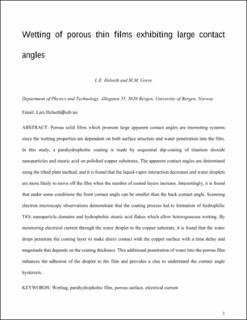| dc.contributor.author | Helseth, Lars Egil | |
| dc.contributor.author | Greve, Martin Møller | |
| dc.date.accessioned | 2023-04-04T07:58:53Z | |
| dc.date.available | 2023-04-04T07:58:53Z | |
| dc.date.created | 2023-03-01T12:29:48Z | |
| dc.date.issued | 2023 | |
| dc.identifier.issn | 0021-9606 | |
| dc.identifier.uri | https://hdl.handle.net/11250/3061969 | |
| dc.description.abstract | Porous solid films that promote large apparent contact angles are interesting systems since their wetting properties are dependent on both the surface structure and water penetration into the film. In this study, a parahydrophobic coating is made by sequential dip coating of titanium dioxide nanoparticles and stearic acid on polished copper substrates. The apparent contact angles are determined using the tilted plate method, and it is found that the liquid–vapor interaction decreases and water droplets are more likely to move off the film when the number of coated layers increases. Interestingly, it is found that under some conditions, the front contact angle can be smaller than the back contact angle. Scanning electron microscopy observations demonstrate that the coating process led to the formation of hydrophilic TiO2 nanoparticle domains and hydrophobic stearic acid flakes that allows heterogeneous wetting. By monitoring the electrical current through the water droplet to the copper substrate, it is found that the water drops penetrate the coating layer to make direct contact with the copper surface with a time delay and magnitude that depends on the coating thickness. This additional penetration of water into the porous film enhances the adhesion of the droplet to the film and provides a clue to understand the contact angle hysteresis. | en_US |
| dc.language.iso | eng | en_US |
| dc.publisher | AIP | en_US |
| dc.title | Wetting of porous thin films exhibiting large contact angles | en_US |
| dc.type | Journal article | en_US |
| dc.type | Peer reviewed | en_US |
| dc.description.version | acceptedVersion | en_US |
| dc.rights.holder | Copyright 2023 The Author(s) | en_US |
| dc.source.articlenumber | 094701 | en_US |
| cristin.ispublished | true | |
| cristin.fulltext | postprint | |
| cristin.qualitycode | 1 | |
| dc.identifier.doi | https://doi.org/10.1063/5.0138148 | |
| dc.identifier.cristin | 2130447 | |
| dc.source.journal | Journal of Chemical Physics | en_US |
| dc.identifier.citation | Journal of Chemical Physics. 2023, 158, 094701. | en_US |
| dc.source.volume | 158 | en_US |
